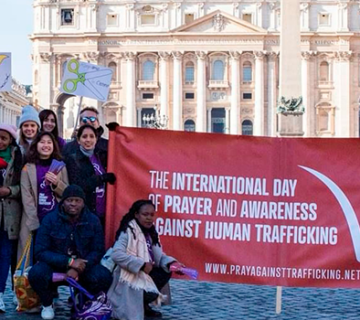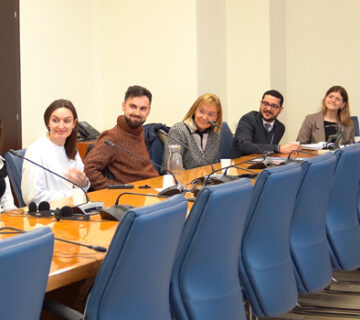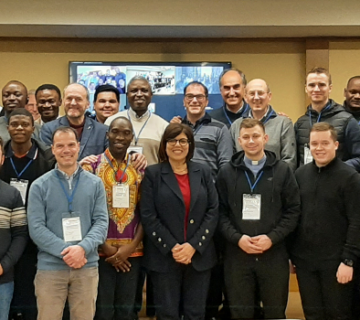 Q. – Among the different prophetical aspects of John Paul II’s pontificate, one would have to include the new page he opened on the vigil of the Feast of Pentecost in 1998, that first historical gathering of hundreds of thousands of members of ecclesial movements and new communities. He publicly recognized them as “significant charismatic expressions of the Church” and he re-affirmed the co-essentiality between the petrine-institutional dimension and the Marian-charismatic dimension. What perspectives are opened up by this vision the Pope has of the Church?
Q. – Among the different prophetical aspects of John Paul II’s pontificate, one would have to include the new page he opened on the vigil of the Feast of Pentecost in 1998, that first historical gathering of hundreds of thousands of members of ecclesial movements and new communities. He publicly recognized them as “significant charismatic expressions of the Church” and he re-affirmed the co-essentiality between the petrine-institutional dimension and the Marian-charismatic dimension. What perspectives are opened up by this vision the Pope has of the Church?
A. – On that day the Pope ignited in us a dream, the dream of the Church of the 3rd millenium, the Church as communion. In this time of re-discovery of the charisms working in unity with one another and in deep communion with the Pope and with the Bishops, I feel great hope that the work of the Holy Spirit will shine forth and will lead the world to Jesus. From that day on, in order to respond to the wish the Pope expressed for communion among the Movements, I assumed the task of initiating a journey of exchange among the people of the movements and new communities. I never would have imagined the developments that we’re seeing today. The Pentecost event was repeated in countless dioceses all over the world, with many bishops present, gathering together hundreds of movements and communities. The result? New vitality and great hope. News of the progress of this journey reached persons of movements and communities of dozens of different Churches, for example, in the Evangelical Lutheran Churches of Germany. I don’t believe such a phenomenon existed before this. And ever since 1999, there has been such friendship, such brotherhood, that the idea came to us to render this brotherhood visible, for example in a wide-scale meeting, and on May 8, 2004, such a meeting will take place in Stuttgart. Through this event we will try to bring through our different charisms a contribution to that reality of the “spirit of Europe”.
Q. – Could you describe your relationship with the Pope?
A. – My relationship with the Pope has increased in depth over the years. As a matter of fact, on one or two occasions, I experienced something extraordinary. For example, after an audience with him, in which I experienced a moment of great unity with the Pope – daughter to father, one could say – I had the feeling that Heaven had opened up, and I experienced a very special union with God. What made it unique was the fact that I felt there were no intermediaries. The Pope is an intermediary. But when a mediator has fulfilled the function of helping the other reach union with God, then that mediator disappears. I sensed that this depends also on the fact that the Pope received the keys to the Kingdom of Heaven. Scripture says: “And I will give you the keys of the Kingdom”. Perhaps he uses these keys not just to cancel our sins, but also to open us up to a deeper union with God. This might explain certain profound changes of heart and changes in the course of history that he has operated over these past 25 years. He communicates God and God is the one who makes all things new. It is a Presence that becomes stronger and stronger the more it is refined by suffering.
Q. – Do any particular episodes with the Pope come to your mind?
A. – Many special moments come to my mind. They mark milestones in the history of our Movement and beyond. One such moment was on Sept. 23, 1985. An audience with the Pope was concluding and I was about to leave. I had in mind the future of our Movement and I dared to ask the Pope, “Would you think it possible that the President of the Focolare Movement (of this Work of Mary, which is “of Mary”), would you think it possible that the President might always be a woman?” “Yes,” he answered, “if only it could be so!” His words, the sentiments that motivated that “yes,” opened up for me for the first time a new awareness about the Church in its two dimensions – the petrine or institutional dimension and the Marian, charismatic, dimension. “Both were present in the early Church,” he said, citing the theologian Hans Urs von Balthasar, “and they need to remain!”
And this is the new element that the Pope has mentioned on several occasions since then. What’s interesting to note is that the Holy Father doesn’t see the Marian profile of the Church as simply a spiritual or mystical reality. He sees it as an historical reality as well, and he bears witness to this conviction with facts, opening up the doors to all the new things that the Holy Spirit wants to work.
Q. – And another episode?
A. – Over the years, the same vocations that exist in the Work of Mary among the Catholics came to life also among the youth, families, persons of various backgrounds, Anglicans, Lutherans, Orthodox and persons of other Churches,. This is something new, and the canonists needed to study it over the years. At one point I thought we would never find the solution. Then I spoke about it with the Pope. He was very open to the idea! During the second audience on this topic, again just as I was about to leave, he said to me with his characteristic intuitive sense, “I understand. It should be said. ‘Don’t interfere with the Work of Mary. It is Mary’s work’!” With that the situation turned around. That very night, a thought came to me: if there is a point which is an obstacle in the ecumenical journey, it’s the magisterium of the Pope. Yet who is the one “welcoming” these focolarini of the other Churches? The Pope. This will remain in our history.
The Holy Father then went even further: he was the one who suggested that even the bishops of other Christian traditions meet regularly as they have been now for years, so as to undergird their ministry with the spirituality of unity already shared by many Catholic bishops. The Pope approved that bond, not a juridical one, but a spiritual bond, with the Work of Mary.


 Italiano
Italiano Español
Español Français
Français Português
Português


